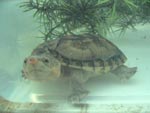Staurotypus salvinii, the Pacific Coast giant musk turtle, is a member of Kinosternidae within Cryptodira. Kinosternidae contains three extant genera and several extinct taxa (Bonin et al., 2006). Long thought to be the sister-group to Trionychidae (e.g., Gaffney, 1975), the relationship of this taxon to other turtles has recently been called into question on the basis of both molecular and morphological features (e.g., Shaffer et al., 1997).
 Staurotypus salvinii is a moderate-sized turtle whose carapace length may reach 25 cm (Ernst and Barbour, 1989; Bonin et al., 2006). Its skull is large for its body size, and exhibits temporal emargination and a secondary palate (Ernst and Barbour, 1989). The oval carapace exhibits three distinct keels and is not serrated, while the small plastron has a slight hinge. Staurotypus salvinii varies in color from olive gray to dark brown, with yellow or orange markings on the head. Staurotypus salvinii and the other species of Staurotypus, S. triporcatus, are unique among kinosternids in the possession of male sex chromosomes (e.g., Bull et al., 1974; Sites et al., 1979).
Staurotypus salvinii is a moderate-sized turtle whose carapace length may reach 25 cm (Ernst and Barbour, 1989; Bonin et al., 2006). Its skull is large for its body size, and exhibits temporal emargination and a secondary palate (Ernst and Barbour, 1989). The oval carapace exhibits three distinct keels and is not serrated, while the small plastron has a slight hinge. Staurotypus salvinii varies in color from olive gray to dark brown, with yellow or orange markings on the head. Staurotypus salvinii and the other species of Staurotypus, S. triporcatus, are unique among kinosternids in the possession of male sex chromosomes (e.g., Bull et al., 1974; Sites et al., 1979).
Staurotypus salvinii inhabits slow-moving bodies of freshwater with soft bottoms and abundant vegetation, from southern Mexico to El Salvador and Guatemala (Ernst and Barbour, 1989; Bonin et al., 2006). It is carnivorous, feeding on aquatic invertebrates, amphibians, and small fish. Females lay several clutches of six to ten eggs per year. Staurotypus salvinii is aggressive and can deliver a powerful bite (Ernst and Barbour, 1989; Bonin et al., 2006).

Literature
Bickham, J.W. and J.L. Carr. 1983. Taxonomy and phylogeny of the higher categories of cryptodiran turtles based on a cladistic analysis of chromosomal data. Copeia 1983:918-932.
Bonin, F., Devaux, B., and A. Dupré. 2006. Turtles of the World. Translated by P.C.H. Pritchard. Johns Hopkins University Press, Baltimore MD.
Bull, J.J., Moon, R.G. and J.M. Legler. 1974. Male heterogamety in Kinosternid turtles (genus Staurotypus). Cytogenetics and Cell Genetics 13:419-425.
Ernst, C.H. and R.W. Barbour. 1989. Turtles of the World. Smithsonian Institution Press, Washington DC.
Ferri, V. 2002. Turtles and Tortoises. Firefly Books, Willowdale, ON.
Gaffney, E.S. 1972. An illustrated glossary of turtle skull nomenclature. American Museum Novitates 2486:1-33.
Gaffney, E.S. 1975. A phylogeny and classification of higher categories of turtles. Bulletin of the American Museum of Natural History 155:387-436.
Gaffney, E.S. 1979. Comparative cranial morphology of recent and fossil turtles. Bulletin of the American Museum of Natural History 164:1-376.
Gaffney, E.S. and P.A. Meylan. 1988. A phylogeny of turtles. In: Benton, M.J., editor. The Phylogeny and Classification of the Tetrapods, Volume 1: Amphibians, Reptiles, Birds. Clarendon Press, Oxford, pp. 157-219.
Joyce, W.G. 2007. A phylogeny of Mesozoic turtles. Bulletin of the Peabody Museum of Natural History 48:3-102.
Meylan, P.A. and E.S. Gaffney. 1989. The skeletal morphology of the Cretaceous cryptodiran turtle, Adocus, and the relationships of the Trionychoidea. American Museum Novitates 2941:1-60.
Orenstein, R. 2001. Turtles, Tortoises, and Terrapins: Survivors in Armor. Firefly Books, Buffalo, NY.
Pritchard, P.C.H. 1979. Encyclopedia of Turtles. TFH Publishing, Neptune FL.
Shaffer, H.B., Meylan, P., and M.L. McKnight. 1997. Tests of turtle phylogeny: molecular, morphological, and paleontological approaches. Systematic Biology 46:235-268.
Sites, J.W., Bickham, J.W. and M.W. Haiduk. 1979. Derived X-chromosome in the turtle genus Staurotypus. Science 206:1410-1412.










